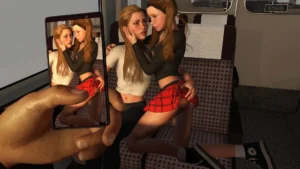
A Girl on a Train
Play A Girl on a Train
A Girl on a Train review
Explore the immersive world and unique mechanics of the ‘A Girl on a Train’ game
If you’re curious about the ‘A Girl on a Train’ game, this article offers a comprehensive look into its gameplay, storyline, and character dynamics. This game stands out for its immersive setting aboard a moving train and its focus on character interaction and progression. Whether you’re a first-time player or looking to deepen your experience, understanding its core features will enhance your gameplay journey.
Understanding the Gameplay and Storyline of ‘A Girl on a Train’
Ever found yourself staring out a train window, wondering about the lives of the people you’re briefly sharing a journey with? 🚄 That exact feeling of fleeting connection and deep curiosity is the heart of A Girl on a Train game. It’s an experience that pulls you into a beautifully crafted interactive story where your decisions truly matter. If you’re tired of games where your input feels meaningless, you’re in for a treat. This isn’t just a passive ride; you’re in the conductor’s seat of your own narrative destiny.
I remember my first playthrough. I thought I’d just be clicking through dialogue, but within minutes, I was completely invested in the fate of the characters I met. The genius of this train setting game is how it uses the confined, moving space to force intimacy and meaningful interaction. You can’t just walk away from a tough conversation; you have to sit with the consequences, making every choice feel weighty and real. It’s a masterclass in atmospheric storytelling.
### What Is ‘A Girl on a Train’ Game About?
At its core, A Girl on a Train game is a narrative-driven adventure where you play as a passenger on a long-distance train journey. 🎭 Your character strikes up a conversation with a fellow traveler, a young woman with a mysterious past and uncertain future. The entire game unfolds through your interactions with her during this journey, making the setting a crucial character in itself.
The gameplay mechanics are deceptively simple. You navigate through conversations, selecting dialogue options, deciding when to press for more information, and choosing which personal details to share about your own life. These aren’t just A/B choices; they shape your relationship’s tone, build trust (or erode it), and unlock different branches of the story. The role-playing game features are deeply woven into these conversations, allowing you to define your own persona through how you respond to her revelations and challenges.
The beauty of this interactive story is its pacing. The rhythm of the train—passing through tunnels, stopping at stations, the changing scenery outside the window—all mirrors the emotional ebbs and flows of your conversation. It creates a uniquely immersive experience that you just don’t get in other games.
### How Does Character Development Work?
This is where A Girl on a Train truly shines. The character development isn’t about leveling up stats or unlocking skills in a traditional sense. 🧠 Instead, it’s an organic, emotional progression for both your character and the woman you’re talking to. You develop through your shared experiences and the vulnerabilities you choose to reveal.
Think of it like this: every conversation is a brick, and the relationship you build is the wall. Some choices add strong, sturdy bricks of trust and understanding. Others might be weaker, creating cracks of doubt or miscommunication. This gradual build-up is the core of the game’s role-playing game features. You aren’t just watching a story; you are actively building a connection, and that connection changes both of you.
Your character can evolve to be empathetic and supportive, cynical and distant, or anything in between. This evolution isn’t just cosmetic; it directly influences which story paths become available. A character who has built a foundation of trust will be confided in and presented with different options than one who has been consistently evasive.
To help you visualize how your actions shape the journey, here’s a breakdown of key conversational approaches and their potential effects:
| Your Approach | Short-Term Effect | Long-Term Impact on Development |
|---|---|---|
| Open & Honest | Builds quick rapport and encourages her to share more. | Unlocks deeper, more personal story branches and a stronger emotional connection. |
| Humor & Deflection | Lightens the mood and avoids intense topics. | May create a fun dynamic but could prevent accessing her deepest fears and secrets. |
| Questioning & Skeptical | Might put her on the defensive or challenge her narrative. | Can lead to confrontational paths and revelations born of conflict, altering the relationship’s foundation. |
| Quiet & Observant | Allows her to lead the conversation at her own pace. | Fosters a sense of safety, potentially leading to her volunteering information without being pressured. |
This system ensures that the character development feels earned and authentic. You’re not just picking “good” or “bad” dialogue options; you’re crafting a personality, and the game world reacts to that personality in a believable way. It’s incredibly rewarding.
### What Choices Influence the Game’s Outcome?
The player choices impact in this game is nothing short of phenomenal. 🧩 We’re not talking about a simple “good ending/bad ending” dichotomy. The narrative branches into a multitude of nuanced conclusions based on a combination of major decisions and subtle conversational nuances. This is the heart of its gameplay mechanics.
Every choice carries weight. Seemingly insignificant decisions, like whether to offer her a snack or change the subject when she looks uncomfortable, can have butterfly effects later on. The game remembers everything. Did you confess a small lie early on? That might come back to haunt the level of trust later. Did you push too hard on a sensitive topic? She might shut down entirely, locking you out of a crucial piece of her story.
The player choices impact extends to the very fate of your traveling companion. Your actions can determine:
* Whether she finds closure on a past trauma.
* The direction she decides to take her life after the train journey ends.
* The nature of your relationship—do you part as close friends, bittersweet acquaintances, or even with unresolved tension?
* The emotional state of your own character by the end of the line.
This complexity is what demands multiple playthroughs. On my second run, I made completely different choices just to see what would happen, and I was stunned by how much of the story I had missed the first time. It truly feels like a different game. The interactive story is so robust that your experience is uniquely yours.
My Tip: Don’t try to “game” the system on your first playthrough. Go with your gut. The most rewarding experience comes from role-playing authentically and seeing where your natural instincts take the story. You can always explore other paths later!
Frequently asked questions about game choices and outcomes
How many different endings are there?
While the developers haven’t released an exact number, the community has discovered numerous distinct endings, each with several variations. The endings are less about “winning” and more about the nuanced conclusion to the relationship and each character’s personal journey.
Can I ruin the relationship permanently?
Yes, absolutely. Certain choices, especially a pattern of dismissive or aggressive behavior, can cause a total breakdown in communication. She may refuse to engage with you for the rest of the journey, leading to a very specific and lonely ending.
Do my choices affect the gameplay mechanics beyond the story?
The core gameplay mechanics are the conversation and story systems, so yes, entirely. Your choices determine which dialogue options become available later. A choice in Chapter 2 might unlock or lock a critical conversation branch in Chapter 5.
Is there a “right” way to play?
No, and that’s the beauty of it. The game is designed to validate your playstyle. Whether you build a deep connection or a fraught one, the narrative accommodates it and makes it a compelling experience. The “right” way is the way you want to play.
The ‘A Girl on a Train’ game offers a unique and engaging experience through its immersive train setting, evolving character development, and impactful player choices. Understanding these elements can greatly enhance your enjoyment and mastery of the game. Dive in, explore the narrative paths, and shape your own story aboard the train.















